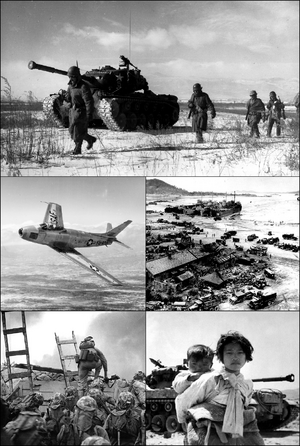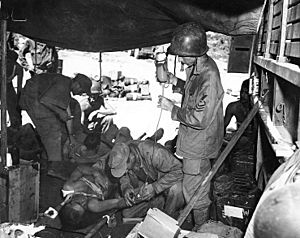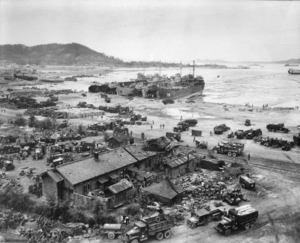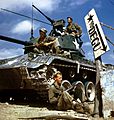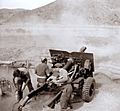Korean War facts for kids
Quick facts for kids Korean WarIn South Korea |
|||||||||
|---|---|---|---|---|---|---|---|---|---|
| Part of the Cold War and the inter-Korean conflict | |||||||||
|
Clockwise from top: A column of the U.S. 1st Marine Division's infantry and armor moves through Chinese lines during their breakout from the Chosin Reservoir • UN landing at Incheon harbor, starting point of the Battle of Incheon • Korean refugees in front of a U.S. M46 Patton tank • U.S. Marines, led by First Lieutenant Baldomero Lopez, landing at Incheon • F-86 Sabre fighter aircraft |
|||||||||
|
|||||||||
The Korean War was a big fight between North Korea and South Korea. It lasted from June 25, 1950, to July 27, 1953. North Korea had help from China and the Soviet Union. South Korea was supported by the United Nations, especially the United States.
The war started when North Korea invaded South Korea on June 25, 1950. This happened after some smaller fights along their border.
Contents
Why the Korean War Started
Korea's Division After World War II
After World War II, Korea was split into two parts. This happened in 1948 because of the Cold War between the Soviet Union and the United States. The border was set at the 38th parallel.
North Korea became a socialist state. It was led by Kim Il-sung, who believed in Communism. South Korea became a capitalist state. It was led by Syngman Rhee, who was against communism.
Both governments believed they should rule all of Korea. Neither side accepted the border as permanent. This disagreement led to many problems.
The Invasion of South Korea
The fighting grew much worse on June 25, 1950. North Korean soldiers, called the Korean People's Army, crossed the border. They quickly moved into South Korea. The Soviet Union and China supported this invasion.
The United Nations Security Council decided to act. They created the United Nations Command. This group sent forces to Korea to stop the North Korean invasion. Twenty-one countries helped the UN force. The United States provided about 90% of the soldiers.
Key Events of the War
North Korea's Early Success
- June 25, 1950: North Korea invaded South Korea. They quickly took control of most of the country. The South Korean army had to retreat to a city called Busan.
UN Forces Fight Back
- July 1950: The United Nations army arrived to help South Korea. They landed at Incheon, a port city. From there, they fought the North Korean army. They pushed them back past the border. UN forces even went deep into North Korea, close to the Chinese border. This was near the Yalu River.
China Joins the Fight
- October 1950: China became worried about the war being so close to its border. They warned the UN and South Korean armies to go back to the border. China said they had no right to fight so far into North Korea.
- The UN forces, led by American General Douglas MacArthur, ignored China's warning.
- So, the Chinese army, called the People's Liberation Army, entered North Korea. They helped the North Koreans push the UN forces back. The UN forces were pushed past the border again.
- During this time, new American fighter jets, the F-86 Sabre, arrived in Korea. They were needed because older American planes were struggling against the Soviet-made MiG-15 jets.
Peace Talks Begin
- February 1951: Fighting continued until the front lines became stable. Neither army was deep inside the other country. This led to the start of peace talks.
- April 11, 1951: General Douglas MacArthur was removed from his command. This happened because he made public statements that went against the US government's plans.
The Armistice Agreement
- March 1951 - July 27, 1953: Peace talks continued for a long time.
- On July 27, 1953, an armistice was signed. An armistice is an agreement to stop fighting. It is not a full peace treaty.
- The agreement created the Korean Demilitarized Zone (DMZ). This is a special area that separates North and South Korea. It also allowed prisoners of war to return home.
- No peace treaty was ever signed. This means North and South Korea are technically still at war. It is a "frozen conflict."
- In April 2018, the leaders of North and South Korea met. They agreed to work towards a treaty to officially end the war.
What Happened After the War
The Korean War had many important results for the countries involved.
| Country | Good Things | Bad Things |
|---|---|---|
| USA | Stopped communism from spreading. Greece and Turkey joined NATO. Showed they would stand up to communism. | Was seen as too aggressive by some countries. |
| UN | It was the UN's first big success in stopping an invasion. | Showed that sometimes force was needed, not just talks. |
| Both Koreas | North Korea made a treaty with China. South Korea remained a capitalist country. | Many people died, and much property was destroyed. The country remained divided. |
| China | The war helped unite the country. It also made its leaders look strong. | Relations with the Soviet Union became worse. China was not allowed in the UN Security Council for a while. |
| USSR | North Korea stayed communist. They could test their air force against the US. | Relations with China became worse. They spent a lot of money on the war. |
Related pages
Images for kids
-
Man of the Year, the American soldier on Time magazine cover, 1951
-
General Douglas MacArthur, UN Command CiC (seated), observes the naval shelling of Incheon from USS Mount McKinley, 15 September 1950
-
US Air Force attacking railroads south of Wonsan on the eastern coast of North Korea
-
B-26 Invaders bomb logistics depots in Wonsan, North Korea, 1951
-
US M46 Patton tanks, painted with tiger heads thought to demoralize Chinese forces
-
The DMZ as seen from the north, 2005
-
Korean War memorials are found in every UN Command Korean War participant country; this one is in Pretoria, South Africa.
-
To disrupt North Korean communications, USS Missouri fires a salvo from its 16-inch guns at shore targets near Chongjin, North Korea, 21 October 1950
-
A B-29 Superfortress bomber dropping its bombs
-
Bob Hope entertained X Corps in Korea on 26 October 1950.
-
The Korean Peninsula at night, shown in a 2012 composite photograph from NASA
See also
 In Spanish: Guerra de Corea para niños
In Spanish: Guerra de Corea para niños


